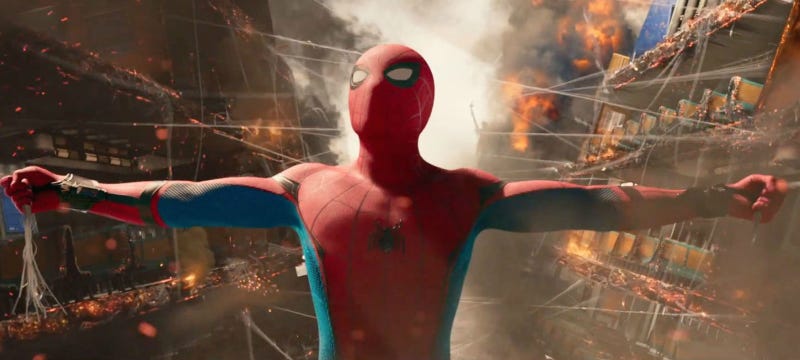One of the best things about Jon Watts' “Spider-Man: Homecoming,” (the
second “Spider-Man” reboot in three years and third overall) is that it isn’t
saddled with burden of delivering Spider-Man’s exhaustive origin story yet
again. He was already introduced in last years “Captain America: Civil War”
(Spidey is now officially part of the MCU, instead of having a standalone
franchise) and therefore we don’t have to watch fifteen minutes of “pre Spider-Man”
Peter Parker.
We don’t have to watch him get bit by a radioactive spider
or comfort his dying Uncle Ben in a dark alley again. It makes for a faster, less
bloated, less redundant “Spider-Man” picture. If I had to watch Uncle Ben get
killed for the third time this
century, or watch a bewildered Parker discover his abilities while starring at
himself in a mirror, I might have walked out. This new iteration of Spiderman is
ready to go: a vigilante with spiderlike powers and snazzy red and blue tights.
Thank god.
Of course, Parker is still a dorky teen with dorky teen
troubles. “Spider-Man: Homecoming” finds a sweet spot between goofy, enduring
teen movie and goofy superhero movie. We’re dropped in the middle of Parker’s
(Tom Holland) hectic life as he balances normal adolescent struggles (fitting
in at school, girl crushes, parties, dances) with crime fighting. These
competing lives often clash in nutty and unexpected: we get an Academic
Decathlon trip that doubles as a superhero mission, that later turns into a
rescue at the Washington Monument. In another scene, Parker and his friend Ned
(Jacob Batalon) dissect an alien weapon during wood shop class. And later on
there’s a delightful superhero inspired twist on the classic
“boy-meeting-his-date’s-father-for-the-first-time” moment.
“Spider-Man: Homecoming” captures the immaturity and
inexperience of its teen protagonist extremely well. Parker is hyper and overly
excited, eager to become a member of The Avengers but is far too undisciplined
and unprepared. His attempt to interrogate a criminal goes horribly wrong, as
do his attempts to stop a bank robbery and save a ferry full of civilians.
Parker bites off more than he can chew when he launches his own investigation
into underground arms dealer Adrian Toomes (Michael Keaton). Parker can
certainly walk the Spider-Man walk but in big moments he’s, more often than
not, amusingly incompetent.
“Spider-Man: Homecoming” is about the consequences of
wanting to grow up too fast, and learning to enjoy just being a kid. Spidey’s
not quite ready to fight with the big boys and that’s okay. It’s a teen angst
movie with a superhero. More so than any other “Spider-Man” movie, “Homecoming”
emphasizes the naive adolescent angle of the character in an appealing and
genuine way. Holland is fantastic, playing Parker with the right amount of
awkward charm and ADD tinged annoyance. Sometimes it’s a blast following him
around and other times I felt kind of embarrassed to be in his presence. Like
any good, well-rounded teen movie protagonist, Parker is adorable and kind of a
nuisance--very relatable in both cases, especially the latter.
Though, perhaps the most enjoyable aspect of “Homecoming” is
just how fun it is. The film zips by and has an easy-going, laissez-faire
attitude It’s a teen angst film that isn’t too angsty; in fact it takes plenty
of opportunities to mock Parker’s angst and the high school film all together.
It’s also very funny; the screenplay by Jonathan Goldstein,
John Francis Daley, Watts, Christopher Ford, Chris Mckenna and Erik Sommers is
packed with jokes and witty banter. Everyone, including the supporting
characters who peek their head in for a scene or two (Hannibal Buress as a gym
teacher) gets be snarky and quick witted. Batalon is a magnificent comedic
sidekick; the montage in which Ned asks Parker an endless barrage of questions
about being Spider-Man is among the film’s highlights. Marissa Tomei has a few
memorably kooky scenes as Aunt May, as does Tony Revolori as a bully of sorts
who is also a DJ and a member of the school’s Academic Decathlon team. All of
which make “Homecoming” irresistibly charming.
As the primary villain, Toomes is solid. He’s not very
memorable, despite Keaton’s hammy, intimidating performance but at least he’s
not the usual power hungry supervillain who wants to level New York City or
raise a drone army or something. He’s just an average, non-flashy, blue-collar
criminal trying to support his family and receive his fair share. As a result
of this, the climactic third act battle ends up being a drastic improvement
over a majority of recent superhero flicks, including “Wonder Woman.” It
doesn’t involve an excessive amount of city damage or an interdimensional
portal having to be closed. It’s refreshingly small scale, coherently staged
and even inventive.
Tony Stark, aka Iron Man (Robert Downey Jr.) shows up
occasionally as a parental figure to give Parker a few “be responsible”
speeches (You know you’re undisciplined when Tony Stark tells you to shape up)
and to remind us that this is an Avengers movie. The efforts to connect Spidey
to the larger MCU can cause the film to lag, especially when it suddenly
becomes an “Iron Man” reunion. Both Jon Favreau and Gwyneth Paltro show up.
That being said, I’ll gladly take an “Iron Man” reunion over watching Uncle Ben
die again.
“Spider-Man: Homecoming” is imperfect but for being the
third “Spider-Man” reboot in fifteen years, it’s pretty damn good and one of
the better recent MCU films.
B















